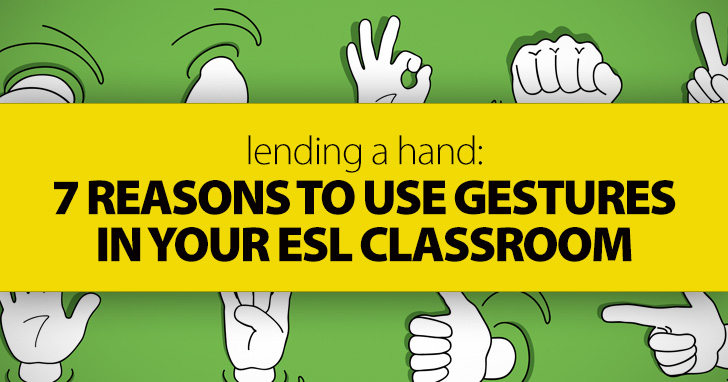Lending a Hand: 7 Reasons to Use Gestures in the ESL Classroom


Keeping your energy high and being creative with your lessons will make your students more attentive. Outside of role play activities, you can use gestures and mime in many different ways. These can aide your students in communicating, understanding, and participating during your lessons.
Giving Directions
Using particular gestures or expressions in the classroom will lead students to associate them with a particular thing. For example, if you always use the same gesture when you say “Please stand up.” students will become accustomed to it and stand up when you use that gesture even if you occasionally leave out the oral instruction. You can have gestures for when you want students to repeat something after you, make groups, or sit down too. This can be especially handy when you want to communicate something to your students in a noisy setting. For instance, if you say “Please turn your desks to make groups of four.” students will begin moving around and making noise as they rearrange their desks so they may miss your verbal instructions to sit down but if you also gesture for them to sit down, at least some students will see it and react accordingly which will cause the remaining students to follow suit.
Vocabulary
Using gestures and mime is important when it comes to vocabulary too. You can use them to elicit certain words and phrases from students. If you teach very young students, it is also common to associate gestures with words to help students remember vocabulary better. Using the same gesture every time you say a particular word or phrase will help these students associate the two.
Practice
In practice dialogues, you can incorporate gestures and mime. If you are teaching a conversation where a customer is complaining about something to a store clerk, for instance, you can tell students that the store clerk should act completely shocked at hearing the news, look apologetic, or whatever else you can think of to make the scenario more realistic. In a conversation where two people are meeting for the first time, have students shake hands as they would do a real life situation. These details make practicing dialogues more fun and interesting.
Production
Activities and games which use gestures and mime can be fun for the whole class. If you have just finished a section on feelings, make a list of feelings on the board and have students choose a slip of paper from a hat. Each slip of paper should contain a sentence such as “You are happy.” Students should keep their sentences a secret. Have one volunteer at a time mime his/her sentence while the rest of the class tries to guess it. This would be a good review activity. To check individual comprehension, you can use the same basic idea but instead turn it into an interview activity where students have a sheet of paper with all the emotions listed as well as their secret emotion. The idea is that students go around the classroom miming and guessing emotions in pairs and getting a student signature for each emotion. When you go through the worksheet as a class you can have students read aloud from their worksheets sentences like “Jane is sad.” and ask Jane to mime being sad for the class.
Cultural
If you are teaching English in a country such as Japan, it is important to consider the fact that lots of communication is nonverbal. When your students have the opportunity to go abroad or interact with other native English speakers, your students may use polite language but if their body language is interpreted differently, they will not have made as good an impression as they were capable of. Your use of simple gestures will help your students. For instance, you can shrug when you do not know the answer, wave to students when you see them outside the classroom, and gesture for students to come up to the board. This will expose students to the types of gestures common in a culture different from their own. Certain gestures may be the same but have different meanings so it is important to explain what they mean to you so that students are not confused.
Do not force yourself to use certain gestures but do what comes naturally and when you find what works for you, stick with it and your students will adapt.